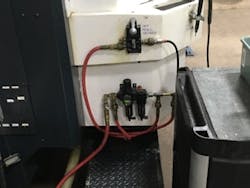You’ve got the right compressor and you’ve specified the right pneumatic tools for each task that compressor powers. But you haven’t maximized efficiency yet. Ten percent to 30% of all energy consumed by the average industrial facility is used to generate compressed air, so you want to be sure you’re getting value for that money – high productivity and minimal waste.
Once you’ve right-sized the compressor and tools, where else can you look for efficiencies? Try looking at the air delivery system between the compressor and the tool. Managing air quality and delivery can prolong equipment life, extend maintenance cycles, and reduce energy consumption. Here’s how.
Air preparation: Room for improvement
Air leaving a compressor usually contains water, compressor oil, dirt, rust, pipe scale, and/or other foreign material, and compressing the air concentrates these contaminants. This creates several potential problems:
- Improper or erratic tool operation
- Premature tool wear and failure
- Shortened component life
- Reduced capacity
- Formation of rust and sludge in the main and branch lines
- Higher operating costs for compressed air
Removing contaminants helps avoid these issues, and the first step is filtration. Installing a general-purpose filter at the main distribution line is a good start, but installing additional filters near the tools can further protect them from damage and wear. Also, choosing the right level of filtration for each tool prevents unnecessary pressure drop (loss of power available to do the job) and extends filter life.
For example, for most tools and equipment, filtering out particles down to 40 microns is sufficient, but for applications such as high-speed pneumatic tool use or process control instrumentation, you may need to filter particles to as small as 5 microns. Paint spraying or food-related applications may require removal of particles down to 1 micron or smaller. Clearly, choosing the right level of filtration is important, but overdoing it is costly. Using a 5 micron filter where 40 microns would be sufficient is not only more expensive initially, but also it could cost more in energy and maintenance. Even where fine filtration is required, you can save money by installing a prefilter upstream to remove larger particles before they clog the finer filter element.
The next step is regulating the air pressure. Yes, there is a pressure switch at the compressor and you always want to have adequate pressure available for full demand, but every item of pneumatic equipment has an optimum operating pressure and flow. Exceeding that pressure rating adds unnecessary loading and wear as well as increasing energy costs. The solution is to install regulators near each tool or set of tools to deliver compressed air at the most efficient pressure.
A note about regulating compressed air: When a pressure drop is detected, it is tempting to just turn up the regulator. You’ll save more by first looking for and solving the problem that caused the pressure drop. For example, undersized piping, dirty filter elements, and friction caused by poor tool lubrication all can contribute to pressure drop.
This brings us to the third step: lubrication. Keeping tools – even prelubricated tools – lubricated can prolong their life and keep them efficient and productive. The air preparation system can be a good way to add continuous lubrication. Typical direct feed (oil-fog) lubricators need to be placed no farther than 15 feet from the tool they are lubricating (and level with or above the tool). Microfog lubricators atomize oil particles so they can travel longer distances, up or down, and through intricate flow paths and lubricate multiple tools.
A lubricator is almost always used after a filter and regulator have preconditioned the air. These can be stand-alone components or integrated as one filter-regulator-lubricator (FRL) combination.
Saving energy: It's not just the compressor
Plant operators are always looking for ways to use the compressor more efficiently, but there are additional opportunities to save energy between the compressor and the tool.
Leakage is the major source of energy loss in air distribution systems. A typical plant can lose 20%–30% of its compressed air, the U.S. Energy Department notes, through poorly connected pipe joints, fittings, or couplings. A single quarter-inch leak can cost more than $5,000 per year in wasted energy, and many such leaks can be repaired in under an hour, so payback is immediate and immense.
Charles Werdehoff is FRL product marketing manager for the Americas at IMI Norgren, where he has worked for more than 35 years. He has extensive air preparation experience and manufacturing experience and can be reached at [email protected].
Misuse is another common cause of waste. Compressed air is an efficient way to deliver high power for air tools, cylinders, valves, air motors, and other air-driven equipment, but sometimes low power is sufficient. For example, low-pressure blowers can be used for applications such as open blowing or aerating liquids. Make sure when you decommission equipment that you shut off the air supply.
Overpressurization, too, wastes energy. In addition to adding regulators, take a look at processes. For example, double-acting cylinders usually only do work on the out-stroke. The return stroke may be accomplished at lower pressure. Where large bore, long-stroke or multiple cylinder systems are used, this can result in considerable air savings. Using a regulator to reduce return stroke pressure can pay for itself quickly.
As with nearly everything else in your plant, regular maintenance of the air distribution system will pay off in higher efficiency. Checking filters at least annually and replacing filter elements before they are blocked will keep you from starving tools of the power they need to perform at their best.
Looking beyond the compressor
As one of the most expensive pieces of equipment to buy and operate, your plant’s air compressor is probably top of mind, but paying attention to the air after it leaves the compressor can pay dividends, too. Proper air preparation and maintenance is fairly simple and very cost-effective.


